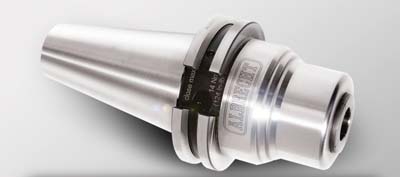
Albrecht Inc. has renamed the Albrecht Power Chuck (APC) line of CNC milling tool holders as the Albrecht Uberchuck. The new name acknowledges both the product's German heritage and the patented technology.
The design of the chuck takes advantage of a patented, two-stage clamping mechanism that reportedly provides significantly higher gripping torque than the widely used shrink-fit and hydraulic tool holders. This results in the extreme rigidity and excellent dampening characteristics that allow more efficient and aggressive cutting, and provide significantly longer cutting-tool life. A further benefit is easier, faster tool changes that save both labor and reduce downtime.
According to Tom Sheridan, Albrecht's Vice President of Marketing: "Independent tests show that our Uberchuck technology can increase tool life by as much as 60 percent. Savings like that can offset conversion costs in a very short time and result in improved profitability down the line. While the case for the Uberchuck is clear, the challenge is overcoming inertia on the part of the manufacturers by helping them to realize that by inaction they may very well be compromising their own bottom lines."
Albrecht Uberchucks are available in three gripping ranges: 1⁄8" to 9/16", 1⁄8" to ¾", and ¾" to 1-¼". All are coolant-ready and pressure rated to 1400 psi. Each is dynamically balanced for high-speed operation, and guaranteed to run within 0.00012" TIR or better at 2.5 x diameter.
Related Glossary Terms
- chuck
chuck
Workholding device that affixes to a mill, lathe or drill-press spindle. It holds a tool or workpiece by one end, allowing it to be rotated. May also be fitted to the machine table to hold a workpiece. Two or more adjustable jaws actually hold the tool or part. May be actuated manually, pneumatically, hydraulically or electrically. See collet.
- computer numerical control ( CNC)
computer numerical control ( CNC)
Microprocessor-based controller dedicated to a machine tool that permits the creation or modification of parts. Programmed numerical control activates the machine’s servos and spindle drives and controls the various machining operations. See DNC, direct numerical control; NC, numerical control.
- gang cutting ( milling)
gang cutting ( milling)
Machining with several cutters mounted on a single arbor, generally for simultaneous cutting.
- milling
milling
Machining operation in which metal or other material is removed by applying power to a rotating cutter. In vertical milling, the cutting tool is mounted vertically on the spindle. In horizontal milling, the cutting tool is mounted horizontally, either directly on the spindle or on an arbor. Horizontal milling is further broken down into conventional milling, where the cutter rotates opposite the direction of feed, or “up” into the workpiece; and climb milling, where the cutter rotates in the direction of feed, or “down” into the workpiece. Milling operations include plane or surface milling, endmilling, facemilling, angle milling, form milling and profiling.
- total indicator runout ( TIR)
total indicator runout ( TIR)
Combined variations of all dimensions of a workpiece, measured with an indicator, determined by rotating the part 360°.






